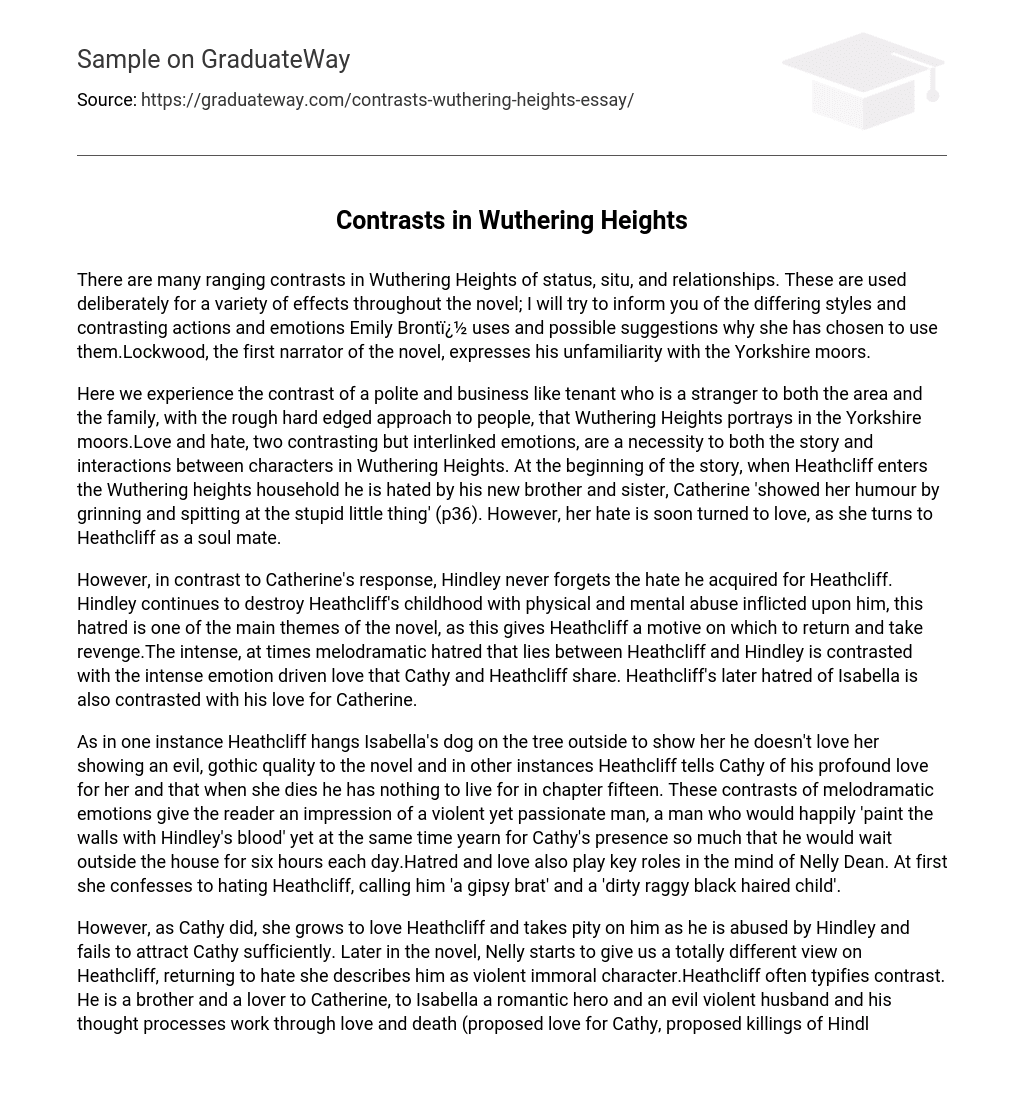There are many ranging contrasts in Wuthering Heights of status, situ, and relationships. These are used deliberately for a variety of effects throughout the novel; I will try to inform you of the differing styles and contrasting actions and emotions Emily Bront� uses and possible suggestions why she has chosen to use them.Lockwood, the first narrator of the novel, expresses his unfamiliarity with the Yorkshire moors.
Here we experience the contrast of a polite and business like tenant who is a stranger to both the area and the family, with the rough hard edged approach to people, that Wuthering Heights portrays in the Yorkshire moors.Love and hate, two contrasting but interlinked emotions, are a necessity to both the story and interactions between characters in Wuthering Heights. At the beginning of the story, when Heathcliff enters the Wuthering heights household he is hated by his new brother and sister, Catherine ‘showed her humour by grinning and spitting at the stupid little thing’ (p36). However, her hate is soon turned to love, as she turns to Heathcliff as a soul mate.
However, in contrast to Catherine’s response, Hindley never forgets the hate he acquired for Heathcliff. Hindley continues to destroy Heathcliff’s childhood with physical and mental abuse inflicted upon him, this hatred is one of the main themes of the novel, as this gives Heathcliff a motive on which to return and take revenge.The intense, at times melodramatic hatred that lies between Heathcliff and Hindley is contrasted with the intense emotion driven love that Cathy and Heathcliff share. Heathcliff’s later hatred of Isabella is also contrasted with his love for Catherine.
As in one instance Heathcliff hangs Isabella’s dog on the tree outside to show her he doesn’t love her showing an evil, gothic quality to the novel and in other instances Heathcliff tells Cathy of his profound love for her and that when she dies he has nothing to live for in chapter fifteen. These contrasts of melodramatic emotions give the reader an impression of a violent yet passionate man, a man who would happily ‘paint the walls with Hindley’s blood’ yet at the same time yearn for Cathy’s presence so much that he would wait outside the house for six hours each day.Hatred and love also play key roles in the mind of Nelly Dean. At first she confesses to hating Heathcliff, calling him ‘a gipsy brat’ and a ‘dirty raggy black haired child’.
However, as Cathy did, she grows to love Heathcliff and takes pity on him as he is abused by Hindley and fails to attract Cathy sufficiently. Later in the novel, Nelly starts to give us a totally different view on Heathcliff, returning to hate she describes him as violent immoral character.Heathcliff often typifies contrast. He is a brother and a lover to Catherine, to Isabella a romantic hero and an evil violent husband and his thought processes work through love and death (proposed love for Cathy, proposed killings of Hindley, Edgar Linton and himself).
Another aspect of contrast which Emily Bront� uses is that of the relationships that Catherine pursues. Even though, as she confesses, her true love is for Heathcliff (‘I am Heathcliff’), when given the choice chooses Edgar Linton due to his social status and monetary stability. This choice that Catherine makes is not only contradictory to her true feelings but pivotal to the plot of the novel, setting up the rest of the story.An obvious contrast in Bront�’s novel is that of class.
The Linton family, who live in the mansion, Thrushcross Grange, are a well to do family living in an upper class environment. Wuthering Heights is seen as a lower to middle class farm house. This contrast is used frequently in the plot, in such occasions as Catherine’s visit to Thrushcross Grange due to being injured by the dog and therefore taken in for a few weeks, this allows her to acquire many upper class qualities, her mannerisms are that of a lady. Also the Linton’s are colder more calculated people of less emotion, the love and hatred which are central to Heathcliff’s life are not seen in Edgar.





